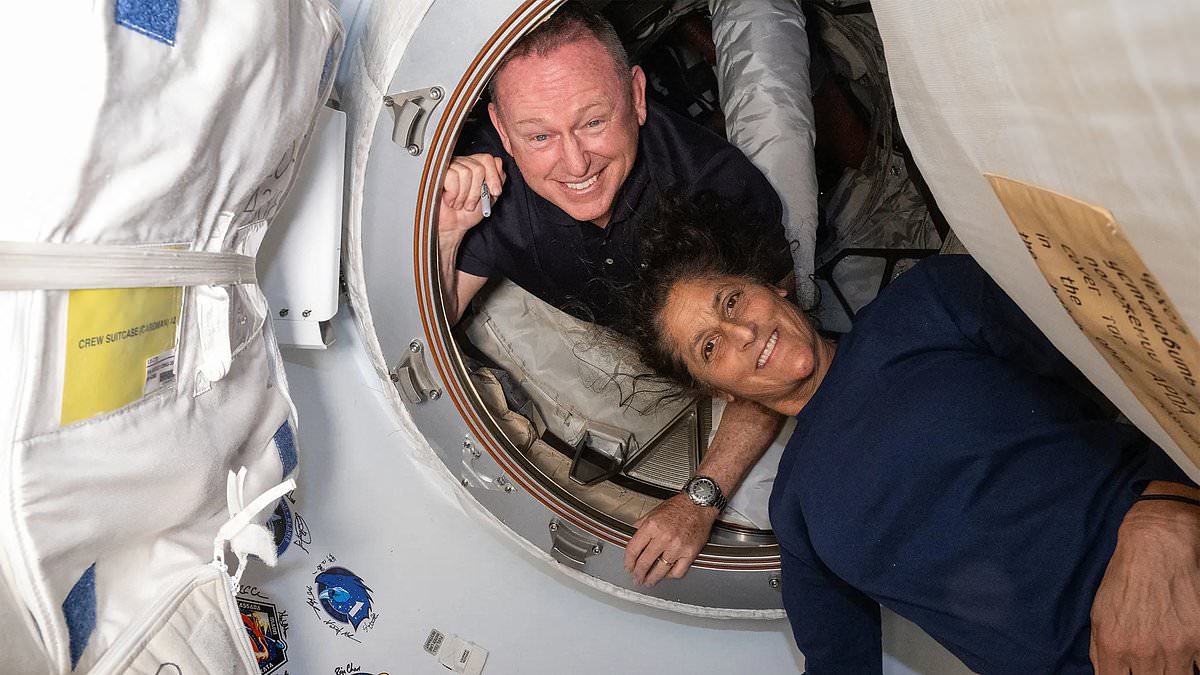The husband of an astronaut trapped in space indefinitely claimed that she won’t be disappointed to be stranded in the cosmos.
Michael Williams, the husband of astronaut Sunita Williams, told the Wall Street Journal that space is his wife’s ‘happy place’ – even as a prospective return flight raises the specter of her being vaporized.
The thrusters on Williams’ Boeing Starliner faulted following its launch in June, meaning they either need to fix – and trust – the Boeing spacecraft to return home, or wait for a Space X option that could last well into next year.
Williams has been alongside Butch Wilmore on the International Space Station (ISS) for two months, and the duo heard this week that their flight back to earth may be delayed yet again.
The soonest Williams and Wilmore may come back is February 2025, as NASA produced a contingency plan that would launch a two-person crew on SpaceX’s Crew-9 mission in September, but still wouldn’t bring the crew home until months later.
When they launched in the spring, the astronaut duo were only intended to be on the ISS for eight days.
But they have cruised past the two month mark without a definite end in sight, and they are forced to remain in orbit over fears that using the Starliner again could end in catastrophe.
The Boeing spacecraft suffered thruster failures and helium leaks, leaving the teams in space to conduct testing to determine if the capsule could fly.
Boeing – which has come under scrutiny this year for a string of aircraft failures and near misses – claimed that it is ‘confident in the Starliner spacecraft and its ability to return safely with crew.’
However, experts told DailyMail.com in June that NASA could be forced to launch a rescue mission, suggesting Elon Musk’s SpaceX would be tapped to get it done.
For their extended time in space, Williams and Wilmore are on the ISS alongside seven other astronauts.
According to the WSJ, their days are typically filled with scientific research and maintenance of the shuttle, as well as educational content such as answering live questions with students and schoolchildren.
They tend to exercise several hours a day to stave off bone and muscle loss typical for space, and their vital signs are monitored from the ground.
Astronauts tend to work and sleep in eight hour periods, although they are technically constantly on call.
Mike Gruntman, professor of astronautics at the University of Southern California, told DailyMail.com that ‘it is more likely that SpaceX would be able to provide an additional launch in the foreseeable future to bring the astronauts back.’
‘It is highly unfortunate that Boeing’s Starliner, after so much delay with its flight, continues to face problems,’ Gruntman continued.
‘For decades, Boeing was one of the most admired aerospace and defense companies. It is a true national tragedy.’
NASA insists that the astronauts are not technically abandoned, and in the case of a dire emergency they could use the Starliner again.
However, the crisis that led the astronauts to remain in space was the result of a disagreement over a plan to use Boeing’s own data to rely on the Starliner’s safety.
While Boeing insists it is safe, Commercial Crew Program chief Steve Stich said officials failed to come to a conclusion.
‘We heard from a lot of folks that had concerns, and the decision was not clear,’ Ken Bowersox, NASA’s space operations chief, added.
While no decision has been made on using Starliner or SpaceX’s Crew Dragon, NASA has been buying Boeing more time to do more testing and gather more data to build a better case to trust Starliner.
The leak that ruined the expedition was first discovered after the Starliner’s first planned launch in May, when teams detected a valve leaking helium and scrubbed the mission.
Engineers suspected that the issue came from a defective rubber seal the size of a shirt button, and said that even if the leak worsens, it could be managed in flight – and set the next launch for June 1.
However, Starliner was again plagued with misfortunes when the capsule was automatically halted with minutes to go before liftoff by a computer-abort system.
The postponement was triggered by computers on the Atlas V rocket’s launchpad that coordinate the final moments before liftoff, but the Starliner capsule appeared healthy, officials said.
The issues sparked concern among a NASA contractor who urged the American space agency to ‘re-double safety checks and re-examine safety protocols to make sure the Starliner is safe before something catastrophic happens.’
Starliner has encountered five failures of its 28 maneuvering thrusters, five leaks of helium gas meant to pressurize those thrusters, and a slow-moving propellant valve that signaled unfixed past issues since launching.
When Starliner arrived in the space station’s vicinity to dock on June 6, the five thruster failures prevented a close approach by the spacecraft until Boeing made a fix.
Over the past several weeks, Boeing has conducted thruster test firings on the ground and in space to understand why five thrusters failed ahead of Starliner’s arrival at the space station.
All but one came back online. Helium leaks in the capsule’s propulsion system also cropped up.
